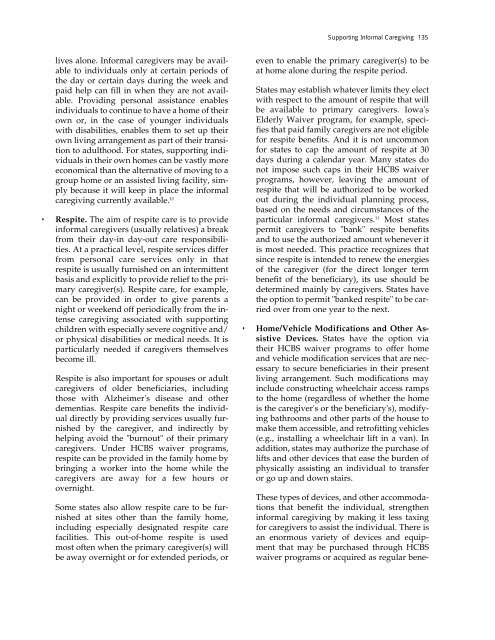Full PDF Version - ASPE - U.S. Department of Health and Human ...
Full PDF Version - ASPE - U.S. Department of Health and Human ...
Full PDF Version - ASPE - U.S. Department of Health and Human ...
- No tags were found...
Create successful ePaper yourself
Turn your PDF publications into a flip-book with our unique Google optimized e-Paper software.
Supporting Informal Caregiving 135lives alone. Informal caregivers may be availableto individuals only at certain periods <strong>of</strong>the day or certain days during the week <strong>and</strong>paid help can fill in when they are not available.Providing personal assistance enablesindividuals to continue to have a home <strong>of</strong> theirown or, in the case <strong>of</strong> younger individualswith disabilities, enables them to set up theirown living arrangement as part <strong>of</strong> their transitionto adulthood. For states, supporting individualsin their own homes can be vastly moreeconomical than the alternative <strong>of</strong> moving to agroup home or an assisted living facility, simplybecause it will keep in place the informalcaregiving currently available. 10• Respite. The aim <strong>of</strong> respite care is to provideinformal caregivers (usually relatives) a breakfrom their day-in day-out care responsibilities.At a practical level, respite services differfrom personal care services only in thatrespite is usually furnished on an intermittentbasis <strong>and</strong> explicitly to provide relief to the primarycaregiver(s). Respite care, for example,can be provided in order to give parents anight or weekend <strong>of</strong>f periodically from the intensecaregiving associated with supportingchildren with especially severe cognitive <strong>and</strong>/or physical disabilities or medical needs. It isparticularly needed if caregivers themselvesbecome ill.Respite is also important for spouses or adultcaregivers <strong>of</strong> older beneficiaries, includingthose with Alzheimer's disease <strong>and</strong> otherdementias. Respite care benefits the individualdirectly by providing services usually furnishedby the caregiver, <strong>and</strong> indirectly byhelping avoid the "burnout" <strong>of</strong> their primarycaregivers. Under HCBS waiver programs,respite can be provided in the family home bybringing a worker into the home while thecaregivers are away for a few hours orovernight.Some states also allow respite care to be furnishedat sites other than the family home,including especially designated respite carefacilities. This out-<strong>of</strong>-home respite is usedmost <strong>of</strong>ten when the primary caregiver(s) willbe away overnight or for extended periods, oreven to enable the primary caregiver(s) to beat home alone during the respite period.States may establish whatever limits they electwith respect to the amount <strong>of</strong> respite that willbe available to primary caregivers. Iowa'sElderly Waiver program, for example, specifiesthat paid family caregivers are not eligiblefor respite benefits. And it is not uncommonfor states to cap the amount <strong>of</strong> respite at 30days during a calendar year. Many states donot impose such caps in their HCBS waiverprograms, however, leaving the amount <strong>of</strong>respite that will be authorized to be workedout during the individual planning process,based on the needs <strong>and</strong> circumstances <strong>of</strong> theparticular informal caregivers. 11 Most statespermit caregivers to "bank" respite benefits<strong>and</strong> to use the authorized amount whenever itis most needed. This practice recognizes thatsince respite is intended to renew the energies<strong>of</strong> the caregiver (for the direct longer termbenefit <strong>of</strong> the beneficiary), its use should bedetermined mainly by caregivers. States havethe option to permit "banked respite" to be carriedover from one year to the next.• Home/Vehicle Modifications <strong>and</strong> Other AssistiveDevices. States have the option viatheir HCBS waiver programs to <strong>of</strong>fer home<strong>and</strong> vehicle modification services that are necessaryto secure beneficiaries in their presentliving arrangement. Such modifications mayinclude constructing wheelchair access rampsto the home (regardless <strong>of</strong> whether the homeis the caregiver's or the beneficiary's), modifyingbathrooms <strong>and</strong> other parts <strong>of</strong> the house tomake them accessible, <strong>and</strong> retr<strong>of</strong>itting vehicles(e.g., installing a wheelchair lift in a van). Inaddition, states may authorize the purchase <strong>of</strong>lifts <strong>and</strong> other devices that ease the burden <strong>of</strong>physically assisting an individual to transferor go up <strong>and</strong> down stairs.These types <strong>of</strong> devices, <strong>and</strong> other accommodationsthat benefit the individual, strengtheninformal caregiving by making it less taxingfor caregivers to assist the individual. There isan enormous variety <strong>of</strong> devices <strong>and</strong> equipmentthat may be purchased through HCBSwaiver programs or acquired as regular bene-
















